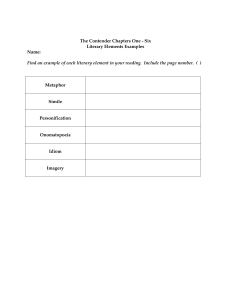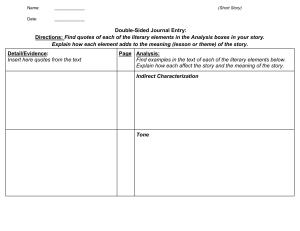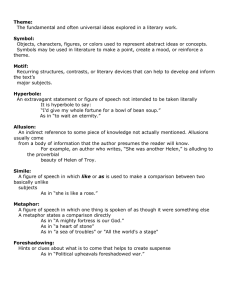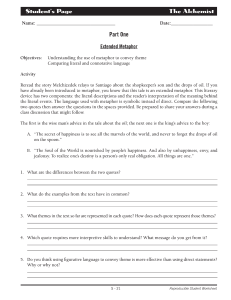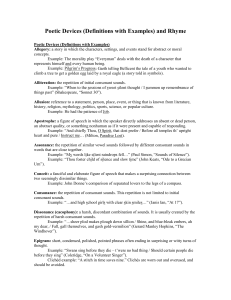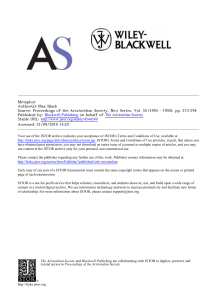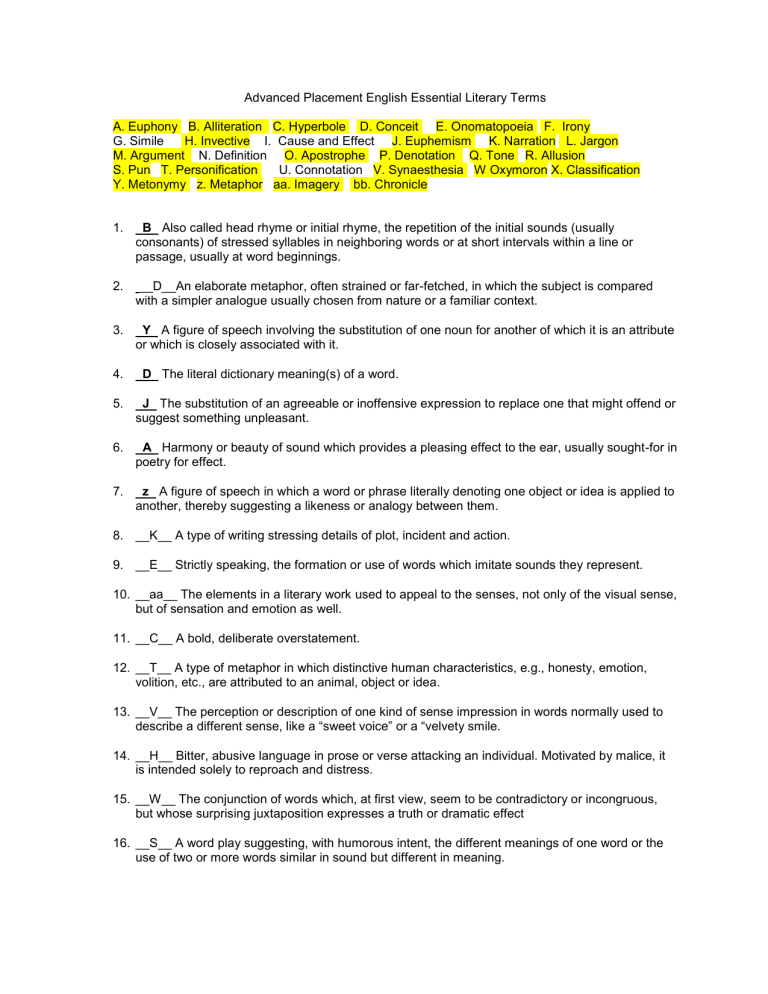
Advanced Placement English Essential Literary Terms A. Euphony B. Alliteration C. Hyperbole D. Conceit E. Onomatopoeia F. Irony G. Simile H. Invective I. Cause and Effect J. Euphemism K. Narration L. Jargon M. Argument N. Definition O. Apostrophe P. Denotation Q. Tone R. Allusion S. Pun T. Personification U. Connotation V. Synaesthesia W Oxymoron X. Classification Y. Metonymy z. Metaphor aa. Imagery bb. Chronicle 1. B Also called head rhyme or initial rhyme, the repetition of the initial sounds (usually consonants) of stressed syllables in neighboring words or at short intervals within a line or passage, usually at word beginnings. 2. __D__An elaborate metaphor, often strained or far-fetched, in which the subject is compared with a simpler analogue usually chosen from nature or a familiar context. 3. Y A figure of speech involving the substitution of one noun for another of which it is an attribute or which is closely associated with it. 4. D The literal dictionary meaning(s) of a word. 5. J The substitution of an agreeable or inoffensive expression to replace one that might offend or suggest something unpleasant. 6. A Harmony or beauty of sound which provides a pleasing effect to the ear, usually sought-for in poetry for effect. 7. z A figure of speech in which a word or phrase literally denoting one object or idea is applied to another, thereby suggesting a likeness or analogy between them. 8. __K__ A type of writing stressing details of plot, incident and action. 9. __E__ Strictly speaking, the formation or use of words which imitate sounds they represent. 10. __aa__ The elements in a literary work used to appeal to the senses, not only of the visual sense, but of sensation and emotion as well. 11. __C__ A bold, deliberate overstatement. 12. __T__ A type of metaphor in which distinctive human characteristics, e.g., honesty, emotion, volition, etc., are attributed to an animal, object or idea. 13. __V__ The perception or description of one kind of sense impression in words normally used to describe a different sense, like a “sweet voice” or a “velvety smile. 14. __H__ Bitter, abusive language in prose or verse attacking an individual. Motivated by malice, it is intended solely to reproach and distress. 15. __W__ The conjunction of words which, at first view, seem to be contradictory or incongruous, but whose surprising juxtaposition expresses a truth or dramatic effect 16. __S__ A word play suggesting, with humorous intent, the different meanings of one word or the use of two or more words similar in sound but different in meaning. 17. __F__ A figure of speech in the form of an expression in which the use of words is the opposite of the thought in the speaker’s mind, thus conveying a meaning that contradicts the literal definition. 18. __bb__ A type of writing that records the details of significant historical events in chronological order. 19. __X__ A type of writing that is concerned with placing an object or person within a group of similar objects and then distinguishing the individual from the group. 20. __R__ An indirect reference to something—usually a literary text such as Shakespeare, The Bible, or mythology—which the reader is supposed to be familiar. 21. __M__ A single claim or series of claims articulated and supported by a writer. 22. __L__ The technical terminology or specialized language of a particular group. 23. __Q__ The author’s attitude toward the subject of the writing. 24. __O__ A figure of speech in which an address is made to an absent person or a personified thing rhetorically.
